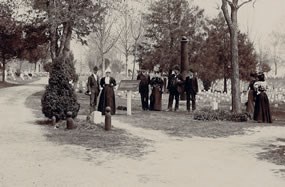
(NPS Photo) In 1866, the War Department established a cemetery on the battlefield of Shiloh, in southwestern Tennessee. In order to bury the dead not only from the April 6-7, 1862, battle of Shiloh but also from all the operations along the Tennessee River, workers began building the “Pittsburg Landing National Cemetery.” Changed to “Shiloh National Cemetery” in 1889, the cemetery holds 3,584 Civil War dead, 2,359 of them unknown. In the fall of 1866, workers disinterred the dead from 156 locations on the battlefield, and 565 different locations along the Tennessee River. Headboards of wood first marked each grave, but were replaced in 1876 and 1877 by granite stones. Tall stones marked the known dead and square, short stones denoted unknown soldiers.
Workers built a stone wall around the cemetery in 1867, and fashioned ornamental iron gates at the entrance in 1911. A superintendent cared for the cemetery until it was officially consolidated with Shiloh National Military Park in 1943. The results of so much labor produced what one observer called “the handsomest cemetery in the South.” Although established as a Civil War burial ground, the Shiloh National Cemetery now holds deceased soldiers from later American wars. Many World War I and II, Korea, and Vietnam burials are in the newest section of the cemetery. There is also one Persian Gulf War memorial. Total interred in the cemetery now stands as 3,892. Although the cemetery was officially closed in 1984, it still averages two or three burials a year, mostly widows of soldiers already interred. There is perhaps no more honorable title than that of “American soldier.” Inscribed on the Tomb of the Unknowns at Arlington National Cemetery are the words, “Here Rests in Honored Glory, An American Soldier, Known But to God.” Thousands of known and unknown American soldiers rest in national and private cemeteries all over the world, as they do in Shiloh National Cemetery. Near the river bank lies six Wisconsin color bearers, all killed in action as they carried their regimental standard into the heat of battle. Just to their west lies Captain Edward Saxe of the 16th Wisconsin, the first Federal officer killed in the battle. Near him lies the teenage drummer boy John D. Holmes of the 15th Iowa. Nearby, two Confederates lie amid so many Union soldiers, their pointed tombstones in stark contrast to the rounded stones of United States soldiers. Across the cemetery lies J.D. Putnam of the 14th Wisconsin, whose 1862 burial inscription on the foot of a tree, cut by his friends in the heat of battle, was still legible in 1901. Near him lies George Ross, a Revolutionary War soldier. In the newest sections of the cemetery, many more recent American soldiers lie in honored glory. One memorial honors a Persian Gulf veteran killed in service. Most sadly, interspersed between all these American soldiers are countless grave stones with only a number identifying them. They too had lives, mothers, perhaps wives, sons, and daughters, fears, hopes, and dreams. All these soldiers, known and unknown, served their country and gave the ultimate sacrifice. They deserve the honor and tribute of Americans, and the title “An American Soldier.” With the exception of the two Confederates, all those interred in the national cemetery are United States soldiers. There has been heated debate concerning why the Confederates are not buried in the cemetery. There are several reasons. Regulations require that only veterans of the United States military can be buried in national cemeteries. As Confederates were technically not United States personnel, they have traditionally been buried elsewhere. Although Congress stipulated in 1956 that Confederate soldiers should be treated the same as United States soldiers, the practice of burying Confederate remains in places other than national cemeteries still exists. Similarly, when taken in the context of Civil War era events, the practice of burying Confederates in national cemeteries was almost nonexistent. The Federal government’s view of former Confederates in 1866, when the cemetery was established, was that of traitors, revolutionaries, the enemy. Burying Confederates in national cemeteries in 1866 would be synonymous with burying American Revolutionary War soldiers in British military cemeteries. As a result, the Confederates who died at Shiloh were not disinterred from their battlefield graves. They remain on the field in several large mass graves and many smaller individual plots. As many as eleven or twelve mass graves exist, but the park commission that created the battlefield could only locate five. Those five are now marked, the largest of these being the mass grave at Tour Stop # 5. National cemeteries and soldier plots are special places, and Shiloh is no different. Buried with these American soldiers is the honor, courage, and sacrifice of an entire American generation. Indeed, these soldiers gave the ultimate sacrifice for what they believed in. Can we of today’s generation learn from these soldiers and meet our own challenges and problems with the same dedication they possessed? Despite different means to wage war, different enemies to face, and different objectives to win, we are still fighting for the same causes they were: life, liberty, and the pursuit of happiness. Perhaps President Lincoln said it best when he declared “that these dead shall not have died in vain,” but that this nation “shall not perish from the earth.” It is our duty to take the standard and make sure Lincoln’s vision is never lost. |
Last updated: April 14, 2015
